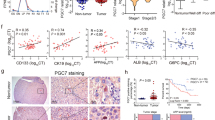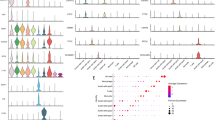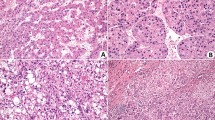Abstract
Aim:
To investigate the roles of P21-activated kinase 5 (PAK5) in proliferation and tumorigenicity of human hepatocellular carcinoma (HCC).
Methods:
HCC and matched paraneoplastictis tissue samples were obtained from 30 patients. Human HCC cell lines SMMC7721, HepG2, Hep3B, SK-HEP-1, Huh-7, and liver cell line HL-7702 were examined. The expression of PAK5 gene was studied using real-time qPCR and Western blotting. Cell proliferation was quantified with the MTT assay. Cell cycle was analyzed with flow cytometry. The tumorigenicity of Lv-shRNA-transfected HepG2 cells was evaluated in BALB/cA nude mice.
Results:
The mRNA level of PAK5 was significantly higher in 25 out of 30 HCC samples compared to the matched paraneoplastic tissues. The HCC cell lines showed varying expression of PAK5 protein, and the highest level was found in the HepG2 cells. PAK5 gene silencing in HepG2 cells markedly reduced the cell proliferation and colony formation, and induced cell cycle arrest in the G1 phase. Furthermore, PAK5 gene silencing suppressed the tumor formation in nude mice, and significantly decreased the expression of HCC-related genes Cyclin D1 and beta-catenin.
Conclusion:
PAK5 may play essential roles in the initiation and progression of human HCC. Thus, it may be an effective therapeutic target or perhaps serve as a clinical diagnostic or prognostic marker in human HCC.
Similar content being viewed by others
Log in or create a free account to read this content
Gain free access to this article, as well as selected content from this journal and more on nature.com
or
Accession codes
References
Bagrodia S, Cerione RA . Pak to the future. Trends Cell Biol 1999; 9: 350–5.
Bokoch GM . Biology of the p21-activated kinases. Annu Rev Biochem 2003; 72: 743–81.
Sells MA, Chernoff J . Emerging from the Pak: the p21-activated protein kinase family. Trends Cell Biol 1997; 7: 162–7.
Jaffer ZM, Chernoff J . p21-activated kinases: three more join the Pak. Int J Biochem Cell B 2002; 34: 713–7.
Pandey A, Dan I, Kristiansen TZ, Watanabe NM, Voldby J, Kajikawa E, et al. Cloning and characterization of PAK5, a novel member of mammalian p21-activated kinase-II subfamily that is predominantly expressed in brain. Oncogene 2002; 21: 3939–48.
Cotteret S, Jaffer ZM, Beeser A, Chernoff J . p21-Activated kinase 5 (Pak5) localizes to mitochondria and inhibits apoptosis by phosphorylating BAD. Mol Cell Biol 2003; 23: 5526–39.
Wu X, Frost JA . Multiple Rho proteins regulate the subcellular targeting of PAK5. Biochem Bioph Res Commun 2006; 351: 328–35.
Cotteret S, Chernoff J . Nucleocytoplasmic shuttling of Pak5 regulates its antiapoptotic properties. Mol Cell Biol 2006; 26: 3215–30.
Dan C, Nath N, Liberto M, Minden A . PAK5, a new brain-specific kinase, promotes neurite outgrowth in N1E-115 cells. Mol Cell Biol 2002; 22: 567–77.
Holm C, Rayala S, Jirstrom K, Stal O, Kumar R, Landberg G . Association between Pak1 expression and subcellular localization and tamoxifen resistance in breast cancer patients. J Natl Cancer Inst 2006; 98: 671–80.
Carter JH, Douglass LE, Deddens JA, Colligan BM, Bhatt TR, Pemberton JO, et al. Pak-1 expression increases with progression of colorectal carcinomas to metastasis. Clin Cancer Res 2004; 10: 3448–56.
Schraml P, Schwerdtfeger G, Burkhalter F, Raggi A, Schmidt D, Ruffalo T, et al. Combined array comparative genomic hybridization and tissue microarray analysis suggest PAK1 at 11q13.5-q14 as a critical oncogene target in ovarian carcinoma. Am J Pathol 2003; 163: 985–92.
Mahlamaki EH, Kauraniemi P, Monni O, Wolf M, Hautaniemi S, Kallioniemi A . High-resolution genomic and expression profiling reveals 105 putative amplification target genes in pancreatic cancer. Neoplasia 2004; 6: 432–9.
Davila M, Frost AR, Grizzle WE, Chakrabarti R . LIM kinase 1 is essential for the invasive growth of prostate epithelial cells: implications in prostate cancer. J Biol Chem 2003; 278: 36868–75.
Gong W, An Z, Wang Y, Pan X, Fang W, Jiang B, et al. P21-activated kinase 5 is overexpressed during colorectal cancer progression and regulates colorectal carcinoma cell adhesion and migration. Int J Can 2009; 125: 548–55.
Wang X, Gong W, Qing H, Geng Y, Wang X, Zhang Y, et al. p21-activated kinase 5 inhibits camptothecin-induced apoptosis in colorectal carcinoma cells. Tumour Biol 2010; 31: 575–82.
Giroux V, Iovanna JL, Garcia S, Dagorn JC . Combined inhibition of PAK7, MAP3K7 and CK2alpha kinases inhibits the growth of MiaPaCa2 pancreatic cancer cell xenografts. Cancer Gene Ther 2009; 16: 731–40.
Ferlay J, Shin HR, Bray F, Forman D, Mathers C, Parkin DM . Estimates of worldwide burden of cancer in 2008: GLOBOCAN 2008. Int J Can 2010; 127: 2893–917.
Coleman JE, Huentelman MJ, Kasparov S, Metcalfe BL, Paton JF, Katovich MJ, et al. Efficient large-scale production and concentration of HIV-1-based lentiviral vectors for use in vivo. Physiol Genomics 2003; 12: 221–8.
Perez-Martinez FC, Alonso V, Sarasa JL, Nam-Cha SG, Vela-Navarrete R, Manzarbeitia F, et al. Immunohistochemical analysis of low-grade and high-grade prostate carcinoma: relative changes of parathyroid hormone-related protein and its parathyroid hormone 1 receptor, osteoprotegerin and receptor activator of nuclear factor-κB ligand. J Clin Pathol 2007; 60: 290–4.
Joo M, Kang YK, Kim MR, Lee HK, Jang JJ . Cyclin D1 overexpression in hepatocellular carcinoma. Liver 2001; 21: 89–95.
Wolfe A, Thomas A, Edwards G, Jaseja R, Guo GL, Apte U . Increased activation of the Wnt/beta-catenin pathway in spontaneous hepatocellular carcinoma observed in farnesoid X receptor knockout mice. J Pharmacol Exp Ther 2011; 338: 12–21.
Dahmani R, Just PA, Perret C . The Wnt/beta-catenin pathway as a therapeutic target in human hepatocellular carcinoma. Clin Res Hepatol Gas 2011; 35: 709–13.
Zekri AR, Bahnassy AA, Alam El-Din HM, Morsy HM, Shaarawy S, Moharram NZ, et al. Serum levels of beta-catenin as a potential marker for genotype 4/hepatitis C-associated hepatocellular carcinoma. Oncol Rep 2011; 26: 825–31.
Xu JM, Wen JM, Zhang M, Lu GL, Wu LZ, Wang WS . A study of gene amplification and expression of cyclin D1 in hepatocellular carcinoma. Zhonghua Bing Li Xue Za Zhi 2004; 33: 26–30.
Deane NG, Parker MA, Aramandla R, Diehl L, Lee WJ, Washington MK, et al. Hepatocellular carcinoma results from chronic cyclin D1 overexpression in transgenic mice. Cancer Res 2001; 61: 5389–95.
Vogelstein B, Kinzler KW . The multistep nature of cancer. Trends Genet 1993; 9: 138–41.
Hanahan D, Weinberg RA . The hallmarks of cancer. Cell 2000; 100: 57–70.
Eswaran J, Soundararajan M, Knapp S . Targeting group II PAKs in cancer and metastasis. Cancer Metast Rev 2009; 28: 209–17.
Kumar R, Gururaj AE, Barnes CJ . p21-activated kinases in cancer. Nat Rev Cancer 2006; 6: 459–71.
Wells CM, Jones GE . The emerging importance of group II PAKs. Biochem J 2010; 425: 465–73.
Yang JX, Han YJ, Zheng H, Luo RC . Expression of PAK4 in breast cancer and benign breast pathological changes. Nan Fang Yi Ke Da Xue Xue Bao 2010; 30: 981–3.
Wells CM, Whale AD, Parsons M, Masters JR, Jones GE . PAK4: a pluripotent kinase that regulates prostate cancer cell adhesion. J Cell Sci 2010; 123: 1663–73.
Li X, Ke Q, Li Y, Liu F, Zhu G, Li F . DGCR6L, a novel PAK4 interaction protein, regulates PAK4-mediated migration of human gastric cancer cell via LIMK1. Int J Biochem Cell Biol 2010; 42: 70–9.
Kaur R, Yuan X, Lu ML, Balk SP . Increased PAK6 expression in prostate cancer and identification of PAK6 associated proteins. Prostate 2008; 68: 1510–6.
Acknowledgements
This study was supported by the Science Technology Program of Zhejiang Province on the Scientific Research Project (2009C33SA800006), the National Natural Science Foundation of China (30872989), and the Scientific Research Foundation for the Junior Teachers of Medicine in the Second Military Medical University (2011QN20).
Author information
Authors and Affiliations
Corresponding authors
Rights and permissions
About this article
Cite this article
Fang, Zp., Jiang, Bg., Gu, Xf. et al. P21-activated kinase 5 plays essential roles in the proliferation and tumorigenicity of human hepatocellular carcinoma. Acta Pharmacol Sin 35, 82–88 (2014). https://doi.org/10.1038/aps.2013.31
Received:
Accepted:
Published:
Issue date:
DOI: https://doi.org/10.1038/aps.2013.31
Keywords
This article is cited by
-
MicroRNA-138-1-3p sensitizes sorafenib to hepatocellular carcinoma by targeting PAK5 mediated β-catenin/ABCB1 signaling pathway
Journal of Biomedical Science (2021)
-
PAK5 promotes the migration and invasion of cervical cancer cells by phosphorylating SATB1
Cell Death & Differentiation (2019)
-
Inhibitors of the p21 Activated Kinases
Current Pharmacology Reports (2018)
-
PAK5-mediated phosphorylation and nuclear translocation of NF-κB-p65 promotes breast cancer cell proliferation in vitro and in vivo
Journal of Experimental & Clinical Cancer Research (2017)
-
PAK5-mediated E47 phosphorylation promotes epithelial–mesenchymal transition and metastasis of colon cancer
Oncogene (2016)



